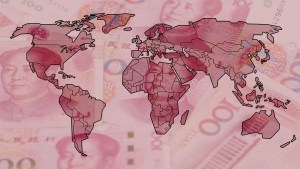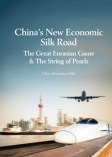Vassal States? Understanding China’s Belt and Road MoU

 The recent announcement by China that it intends to establish Belt and Road arbitration courts to resolve trade and related disputes along the Belt and Road routes – in China – has raised eyebrows as this goes against the generally accepted principal of utilizing an independent, third party as arbitrator. It is unusual for arbitration cases to be heard in a jurisdiction that has laws governing just one of the conflicted parties for obvious reasons of conflict of interest.
The recent announcement by China that it intends to establish Belt and Road arbitration courts to resolve trade and related disputes along the Belt and Road routes – in China – has raised eyebrows as this goes against the generally accepted principal of utilizing an independent, third party as arbitrator. It is unusual for arbitration cases to be heard in a jurisdiction that has laws governing just one of the conflicted parties for obvious reasons of conflict of interest.
To establish how China may be able to pressure other countries to use its courts, we have examined a number of the MoUs China has signed with foreign governments, principally over the past 18 months to examine what has been agreed to or implied. Some of these, but not all, have been released as a matter of public record onto the public domain, and while there are differences in terms of the trade context in each – different countries have different trading environments with China, and regionally, than others – the basic structure of the agreements tends to have remained the same.
However, examination of the MoUs raise a number of other points about China’s intentions in having structured these, not least the clouding of their legitimacy, and apparent willingness to hang these (officially non-binding agreements) onto other existing legal platforms. These agreements also largely tend to favor China trade and institutions rather than those of the co-signatory, despite these being bilaterally agreed documents.
By clicking here, readers may download a cleaned up version of such an MoU, stripped of country and related identification and composed as one draft from several of the MoUs we have examined. The comments below refer to the draft provided. It should be noted that the draft does not represent any agreement the People’s Republic of China has entered into with any other nation. It is an edited sample only, and may not be used to imply any other agreements or otherwise; it is an unofficial document that has not been issued by the Chinese government. It is merely provided for academic interest and reference.
An interesting point to note is at the end of the document, where both parties agree that the document is not legally binding. However, this means that while the MoU itself may be seen as purely a cosmetic exercise to “keep China happy” as has been explained to me by more than one diplomat, the inference swings to the implications and potential manner in which certain elements within the MoU could be interpreted by either party, and especially the Chinese. Such interpretations can, in fact, influence the way in which China views statements made within the MoU, and regard these as important in future diplomatic talks. In short, the purpose of these non-legally binding MoU is to influence, rather than direct – a subtlety that may be lost on some of the signatories.
Of particular interest are the sections I have marked as follows:
- Much of the first part of the clause is jargon, then gets into the trade aspect. The Chinese seem keen on the “win-win” concept. The “integration of different civilizations” could be used as justification for Sinicization and/or atheism from the Chinese viewpoint.
- This clause typically details previously discussed areas of trade cooperation and varies from country to country.
- Clause 3 suggests that signatories are of the same mind when it comes to political issues concerning the BRI – and by implication, suggests agreement with China on its political agenda. Interestingly, it also references and attempts to bring into the MoU, other bilateral/multilateral agreements that China itself may not be a signatory too. For example, the MoU signed with certain EU members quote the EU, and with ASEAN members, ASEAN, and so on. This is despite the EU not having a trade agreement with China, and implies that China can count on the support of signatory MoU nations in dealings with trade or regional bodies that China itself is not a signatory to.
- This clause expands upon this theme and goes deeper to identify specific areas of cooperation in trade and commerce and commits to utilizing other existing platforms to do so. This implies legitimate acceptance for the MoU by committing signatories to “hanging it” onto other, legally binding agreements. It also includes a reference to “congratulating and supporting” China, putting the signatory in the position of supplicant and China as being the acclaimed party to the MoU. This could imply subservience from the Chinese perspective.
- This again quotes existing, and legally binding agreements, such as Bilateral Investment Treaties and other trade agreements that may be in force, and attempts to bind this MoU to them.
- This clause typically identifies existing commercial facilities, such as ports, airports, terminals, and other infrastructure that exist, both sovereign-owned and within trade blocs the signatory is party to, seeking to solicit specific approval for Chinese use of these.
- This clause encourages the joint development of integrated standards with China, and especially those involved with trade facilitation. It is unilateral in the sense that it only specifies “easier access of Chinese exports” and not those of the signatory party to the MoU.
- The promotion of “Innovation Parks” is a new concept, yet it has been included in several (but not all) of the MoUs. This will be to encourage the sharing (with China) of new technologies.
- Of interest is the implied support for the Chinese owned Asian Infrastructure Investment Bank over other existing global institutions, such as the World Bank, IMF, and other similar institutions.
- This clause implies specific support for Chinese government funded bodies, such as the Confucius Institute, which while not named has already taken up residency in several overseas universities. While the clause itself appears benign, there are matters of concern over Chinese Trojan horses being introduced into national institutions.
- This clause deals with sharing of personnel and training, as well as of information, which may loosely be seen to include citizen’s personal, financial, and other data.
- This clause seeks again to tie what is a non-legally binding MoU to a specific agreement and commission that is legally binding and already in existence, thus lending the MoU more ability to claim legitimacy.
- The statement that the MoU is not legally binding. However, the MoU itself contains five separate references to agreements and existing institutions that are legally binding and/or operational on both a bilateral and multilateral basis.
- This clause calls for “friendly consultations” rather than any court or arbitration system in the event of any “differences of interpretation”. This suggests that the recent issue of China setting up Belt and Road arbitration courts in China has been a very recent move, possibly driven by China’s internal judiciary rather than by the foreign ministry.
- The MoUs are typically in force for five years, but on a rolling basis, unless one or the other party decides to cancel it.
Conclusion
The MoU appear largely benign; however, it does contain the seeds of what could, in future, be used as diplomatic tools in terms of insisting that agreements have been reached over certain areas. There is also the creeping shadow of suzerainty cropping up in clause 4. The tying of the MoU as a non-binding agreement to agreements and institutions that already exist is a manner in which the MoU could later be seen to have implied legitimacy. Where the MoU does tend to veer towards unilateral preference, those preferences appear to benefit China and its institutions and trade, rather than those of the foreign signatory. It remains unsure how these MoUs will be used in future to influence diplomatic talks; however, the fact they refer to legitimate institutions and are signed off at government representative level does mean they could carry rather more future political influence than initially meets the eye – which is almost certainly the precise point.
About Us
Chris Devonshire-Ellis is the Chairman of Dezan Shia & Associates. The firm is a pan-Asia foreign direct investment advisory practice and advises both foreign governments and MNC’s on their business strategy, due diligence, and operational issues throughout China, India, ASEAN, Russia and the Belt & Road regions. To contact the firm please email to asia@dezshira.com or visit the practice at www.dezshira.com
 Related Reading:
Related Reading:
![]() Confusion over Dispute Resolution at China’s New Belt and Road Courts
Confusion over Dispute Resolution at China’s New Belt and Road Courts
![]() Suzerainty Issues Hold Up The Wests’ Embracing Of China’s Belt & Road
Suzerainty Issues Hold Up The Wests’ Embracing Of China’s Belt & Road
Silk Road and OBOR Business Intelligence
Dezan Shira & Associates´ Silk Road and OBOR investment brochure offers an introduction to the region and an overview of the services provided by the firm. It is Dezan Shira´s mission to guide investors through the Silk Road´s complex regulatory environment and assist with all aspects of establishing, maintaining and growing business operations in the region.
China’s New Economic Silk Road
This unique and currently only available study into the proposed Silk Road Economic Belt examines the institutional, financial and infrastructure projects that are currently underway and in the planning stage across the entire region. Covering over 60 countries, this book explores the regional reforms, potential problems, opportunities and longer term impact that the Silk Road will have upon Asia, Africa, the Middle East, Europe and the United States.







